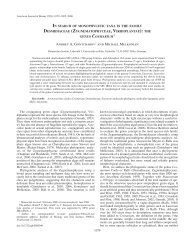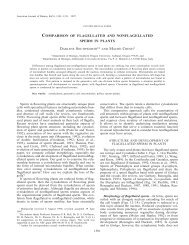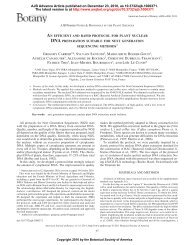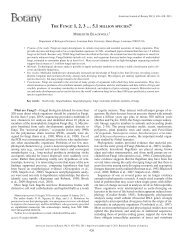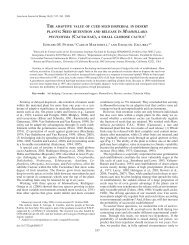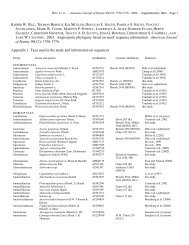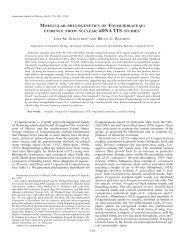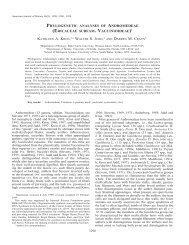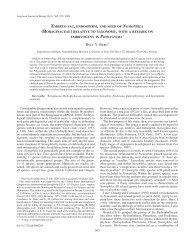phenylurea cytokinins assayed for induction of shoot buds in the ...
phenylurea cytokinins assayed for induction of shoot buds in the ...
phenylurea cytokinins assayed for induction of shoot buds in the ...
Create successful ePaper yourself
Turn your PDF publications into a flip-book with our unique Google optimized e-Paper software.
American Journal <strong>of</strong> Botany 86(11): 1645–1648. 1999.<br />
BRIEF COMMUNICATION<br />
PHENYLUREA CYTOKININS ASSAYED FOR INDUCTION OF<br />
SHOOT BUDS IN THE MOSS FUNARIA HYGROMETRICA 1<br />
MICHAEL L. CHRISTIANSON 2 AND JASON S. HORNBUCKLE<br />
Division <strong>of</strong> Biological Sciences, Department <strong>of</strong> Ecology and Evolutionary Biology, University <strong>of</strong> Kansas,<br />
Lawrence, Kansas 66045<br />
The <strong><strong>in</strong>duction</strong> <strong>of</strong> <strong>shoot</strong> <strong>buds</strong> from <strong>the</strong> filamentous protonema <strong>of</strong> moss is a classic bioassay <strong>for</strong> cytok<strong>in</strong><strong>in</strong>. While a large<br />
literature documents this response <strong>in</strong> many species <strong>of</strong> moss and <strong>for</strong> a wide range <strong>of</strong> natural and syn<strong>the</strong>tic <strong>cytok<strong>in</strong><strong>in</strong>s</strong>, to date<br />
only substituted aden<strong>in</strong>e <strong>cytok<strong>in</strong><strong>in</strong>s</strong> have been exam<strong>in</strong>ed <strong>in</strong> detail. This paper shows that at least some <strong>of</strong> <strong>the</strong> novel <strong>phenylurea</strong><br />
<strong>cytok<strong>in</strong><strong>in</strong>s</strong> will <strong>in</strong>duce bud <strong>for</strong>mation <strong>in</strong> mosses. Funaria responds to thidiazuron much as it responds to benzyladen<strong>in</strong>e.<br />
Exposure to ei<strong>the</strong>r substance results <strong>in</strong> log-l<strong>in</strong>ear dose-dependent <strong>in</strong>creases <strong>in</strong> bud number that reach similar maximal<br />
numbers <strong>of</strong> <strong>buds</strong> at <strong>the</strong> optimal concentration <strong>of</strong> compound. The related compound chloro-pyridyl-<strong>phenylurea</strong> (CPPU) is<br />
slightly less active, but <strong>in</strong>duces <strong>buds</strong> over a wider range <strong>of</strong> concentration. Carbanilide (di<strong>phenylurea</strong> or DPU), an active<br />
cytok<strong>in</strong><strong>in</strong> <strong>in</strong> o<strong>the</strong>r systems, <strong>in</strong>duces very few <strong>buds</strong> <strong>in</strong> Funaria, but does so over a wide range <strong>of</strong> concentration. Bioassay <strong>of</strong><br />
mixtures <strong>of</strong> benzyladen<strong>in</strong>e and DPU f<strong>in</strong>ds no evidence <strong>of</strong> competition <strong>for</strong> cytok<strong>in</strong><strong>in</strong> receptors. That result could support<br />
suggestions that <strong>the</strong> <strong>phenylurea</strong> <strong>cytok<strong>in</strong><strong>in</strong>s</strong> act <strong>in</strong>directly, by alter<strong>in</strong>g endogenous cytok<strong>in</strong><strong>in</strong> metabolism, but we favor ano<strong>the</strong>r<br />
<strong>in</strong>terpretation. Unlike o<strong>the</strong>r cytok<strong>in</strong><strong>in</strong>-responsive systems, <strong>the</strong> <strong><strong>in</strong>duction</strong> <strong>of</strong> <strong>buds</strong> from moss protonema <strong>in</strong>volves two cytok<strong>in</strong><strong>in</strong>-mediated<br />
events. The number <strong>of</strong> <strong>buds</strong> is controlled by <strong>the</strong> second cytok<strong>in</strong><strong>in</strong>-mediated event. If DPU has little or no<br />
aff<strong>in</strong>ity <strong>for</strong> <strong>the</strong> receptor trigger<strong>in</strong>g this second event, DPU treatments will produce few to no <strong>buds</strong>, and k<strong>in</strong>etic analysis<br />
us<strong>in</strong>g bud number would f<strong>in</strong>d no evidence <strong>for</strong> competition with benzyladen<strong>in</strong>e. Our results would support <strong>the</strong> hypo<strong>the</strong>sis<br />
that bud <strong><strong>in</strong>duction</strong> <strong>in</strong> Funaria <strong>in</strong>volves two chemically dist<strong>in</strong>ct cytok<strong>in</strong><strong>in</strong> receptors.<br />
Key words: bud <strong>for</strong>mation; cytok<strong>in</strong><strong>in</strong>; Funaria hygrometrica; moss; <strong>phenylurea</strong>; plant developmental biology.<br />
Mosses grown <strong>in</strong> vitro progress through <strong>the</strong> same developmental<br />
stages as mosses grow<strong>in</strong>g <strong>in</strong> nature. In Funaria<br />
hygrometrica, spores germ<strong>in</strong>ate and give rise to <strong>the</strong><br />
chloroplast-rich chloronema; with time, caulonemal filaments<br />
appear, and eventually cells <strong>in</strong> <strong>the</strong>se filaments beg<strong>in</strong><br />
to undergo a special set <strong>of</strong> divisions to produce <strong>shoot</strong><br />
<strong>buds</strong>. These <strong>buds</strong> grow <strong>in</strong>to <strong>the</strong> leafy <strong>shoot</strong>s or gametophores.<br />
Under appropriate conditions, gametangia are<br />
produced, and sporophytes appear after successful fertilizations.<br />
Exogenous application <strong>of</strong> plant hormones will<br />
facilitate <strong>the</strong>se transitions: aux<strong>in</strong> <strong>for</strong> <strong>the</strong> transition from<br />
chloronema to caulonema, cytok<strong>in</strong><strong>in</strong> to <strong>in</strong>duce <strong>the</strong> <strong>for</strong>mation<br />
<strong>of</strong> <strong>buds</strong> (Bopp, 1990; Bhatla, 1994). Indeed, <strong>the</strong><br />
ability to count <strong>buds</strong> on protonemata has allowed bud<br />
<strong>for</strong>mation to be a classic bioassay <strong>for</strong> cytok<strong>in</strong><strong>in</strong> activity.<br />
Exposure to most <strong>cytok<strong>in</strong><strong>in</strong>s</strong> results <strong>in</strong> log-l<strong>in</strong>ear dosedependent<br />
<strong>in</strong>creases <strong>in</strong> bud number. Stimulation <strong>of</strong> bud<br />
<strong>for</strong>mation can usually be detected at concentrations <strong>of</strong><br />
10 8 mol/L, and maximal numbers <strong>of</strong> <strong>buds</strong> result from<br />
exposures to optimal concentrations <strong>of</strong> 10 6 mol/L<br />
(Brandes and Kende, 1968; Valadon and Mummery,<br />
1971).<br />
The responsiveness to cytok<strong>in</strong><strong>in</strong> seems to be a univer-<br />
1 Manuscript received 31 March 1999; revision accepted 13 July<br />
1999.<br />
The authors thank Dr. Richard Amas<strong>in</strong>o (U. Wiscons<strong>in</strong>) <strong>for</strong> ask<strong>in</strong>g<br />
about <strong>the</strong> activity <strong>of</strong> <strong>phenylurea</strong> <strong>cytok<strong>in</strong><strong>in</strong>s</strong> <strong>in</strong> mosses, Dr. Richard<br />
Schowen (U. Kansas) <strong>for</strong> enlighten<strong>in</strong>g discussions about analyz<strong>in</strong>g k<strong>in</strong>etic<br />
<strong>in</strong>teractions, and Sharon Hagen <strong>for</strong> f<strong>in</strong>al preparation <strong>of</strong> <strong>the</strong> figures.<br />
Work was supported by undergraduate research funds from <strong>the</strong> Division<br />
<strong>of</strong> Biological Sciences, <strong>the</strong> University <strong>of</strong> Kansas General Research<br />
Fund, NSF grant OSR-9550487, and match<strong>in</strong>g support from <strong>the</strong> State<br />
<strong>of</strong> Kansas.<br />
2 Author <strong>for</strong> correspondence.<br />
1645<br />
sal property <strong>of</strong> mosses and is documented <strong>in</strong> <strong>the</strong> literature<br />
by a large number <strong>of</strong> papers that exam<strong>in</strong>e <strong>the</strong> effects <strong>of</strong><br />
various substituted aden<strong>in</strong>es, both natural and syn<strong>the</strong>tic,<br />
on bud <strong>for</strong>mation <strong>in</strong> a wide range <strong>of</strong> mosses (summarized<br />
<strong>in</strong> Chopra and Kumar, 1988). These surveys usually f<strong>in</strong>d<br />
one or <strong>the</strong> o<strong>the</strong>r <strong>of</strong> <strong>the</strong> <strong>cytok<strong>in</strong><strong>in</strong>s</strong> is significantly more<br />
effective at <strong>in</strong>duc<strong>in</strong>g <strong>buds</strong> <strong>in</strong> a particular species, us<strong>in</strong>g<br />
ei<strong>the</strong>r <strong>of</strong> two end-po<strong>in</strong>ts: <strong>the</strong> absolute number <strong>of</strong> <strong>buds</strong><br />
produced at equimolar concentrations or as <strong>the</strong> compound<br />
that stimulates bud <strong>for</strong>mation at <strong>the</strong> lowest concentration.<br />
No overarch<strong>in</strong>g structure–activity relationships have<br />
come from this work, perhaps <strong>in</strong> part because o<strong>the</strong>r factors<br />
<strong>in</strong> <strong>the</strong> bioassay conditions may also be play<strong>in</strong>g a role.<br />
Recently, <strong>for</strong> example, <strong>the</strong> choice <strong>of</strong> gell<strong>in</strong>g agent has<br />
been shown to modulate <strong>the</strong> bud-<strong>for</strong>m<strong>in</strong>g response <strong>of</strong><br />
moss protonema (Hadeler, Scholz, and Reski, 1995).<br />
While <strong>the</strong> natural <strong>cytok<strong>in</strong><strong>in</strong>s</strong> and <strong>the</strong> syn<strong>the</strong>tic <strong>cytok<strong>in</strong><strong>in</strong>s</strong><br />
based on <strong>the</strong>m are all substituted aden<strong>in</strong>es, a series<br />
<strong>of</strong> <strong>phenylurea</strong>s have also been shown to have cytok<strong>in</strong><strong>in</strong><br />
activity (Bruce and Zwar, 1966). These compounds were<br />
developed <strong>for</strong> commercial use as defoliants <strong>in</strong> cotton and<br />
o<strong>the</strong>r crops, are active <strong>in</strong> a number <strong>of</strong> cytok<strong>in</strong><strong>in</strong> bioassays,<br />
and are now widely used as <strong>cytok<strong>in</strong><strong>in</strong>s</strong> <strong>in</strong> higher<br />
plant tissue culture and micropropagation protocols (Shudo,<br />
1994). Although bud <strong>for</strong>mation <strong>in</strong> moss is a classic<br />
demonstration <strong>of</strong> <strong>the</strong> dramatic response <strong>of</strong> plants to cytok<strong>in</strong><strong>in</strong>,<br />
a survey <strong>of</strong> <strong>the</strong> literature f<strong>in</strong>ds only <strong>in</strong>cidental<br />
comments us<strong>in</strong>g this bioassay with <strong>the</strong> <strong>phenylurea</strong> <strong>cytok<strong>in</strong><strong>in</strong>s</strong><br />
(no activity: Brandes and Kende, 1968; Hahn and<br />
Bopp, 1968; low activity: Valadon and Mummery, 1971).<br />
In this paper we report that <strong>the</strong> <strong>phenylurea</strong> <strong>cytok<strong>in</strong><strong>in</strong>s</strong><br />
chloro-pyridyl-<strong>phenylurea</strong>, CPPU, and thidiazuron, TDZ,<br />
will <strong>in</strong>duce bud <strong>for</strong>mation <strong>in</strong> <strong>the</strong> moss Funaria hygro-
1646 AMERICAN JOURNAL OF BOTANY<br />
[Vol. 86<br />
Fig. 1. Numbers <strong>of</strong> <strong>buds</strong> <strong>of</strong> Funaria hygrometrica <strong>in</strong>duced by exposure<br />
to standard and <strong>phenylurea</strong> <strong>cytok<strong>in</strong><strong>in</strong>s</strong>. Dark-grown protonemata<br />
were transferred to medium supplemented with various concentrations<br />
<strong>of</strong> benzyladen<strong>in</strong>e (solid circles) or one <strong>of</strong> three <strong>phenylurea</strong> <strong>cytok<strong>in</strong><strong>in</strong>s</strong>:<br />
thidiazuron (open circles), CPPU (open squares), or DPU (solid triangles)<br />
and cultured <strong>in</strong> <strong>the</strong> light. Buds were counted 7 d after movement<br />
to cytok<strong>in</strong><strong>in</strong>-supplemented medium. N 9; error bars represent SEM.<br />
metrica, and this <strong><strong>in</strong>duction</strong> is dose-dependent. The related<br />
compound, di<strong>phenylurea</strong>, DPU, an active cytok<strong>in</strong><strong>in</strong> <strong>in</strong><br />
o<strong>the</strong>r bioassay systems (Shudo, 1994), <strong>in</strong>duces only very<br />
small numbers <strong>of</strong> <strong>buds</strong> <strong>in</strong> moss, and this stimulation is<br />
dose-<strong>in</strong>dependent from 10 9 mol/L to 10 6 mol/L. We<br />
fur<strong>the</strong>r show that DPU does not <strong>in</strong>hibit <strong>the</strong> stimulation<br />
<strong>of</strong> bud <strong>for</strong>mation by <strong>the</strong> substituted aden<strong>in</strong>e cytok<strong>in</strong><strong>in</strong>,<br />
benzyladen<strong>in</strong>e, even when present <strong>in</strong> 20-fold excess.<br />
MATERIALS AND METHODS<br />
Plant material—The isolates <strong>of</strong> Funaria hygrometrica used <strong>in</strong> <strong>the</strong>se<br />
experiments were <strong>the</strong> ‘‘Duke’’ clone orig<strong>in</strong>ally isolated and described<br />
by Dr. Jon Shaw (1991) and <strong>the</strong> ‘‘Stream’’ clone, collected <strong>in</strong> nor<strong>the</strong>rn<br />
Alberta by MLC. Aseptic cultures were established from spores (Saunders<br />
and Hepler, 1983), are ma<strong>in</strong>ta<strong>in</strong>ed by serial subculture, and are<br />
stored as cryopreserved stocks (Christianson, 1998a).<br />
As described previously (Christianson, 1998b), ra<strong>the</strong>r than select<br />
light-grown colonies <strong>of</strong> moss just as <strong>the</strong> first caulonemal (cytok<strong>in</strong><strong>in</strong>responsive)<br />
filaments appear (Brandes and Kende, 1968), experiments<br />
<strong>in</strong> our laboratory use <strong>the</strong> cytok<strong>in</strong><strong>in</strong>-responsive protonema generated as<br />
dark-grown caulonema (Doonan et al., 1986). Three small pieces <strong>of</strong> a<br />
stock culture are <strong>in</strong>oculated onto sterile 7-cm Whatman number 1 filter<br />
papers placed on basal medium and <strong>in</strong>cubated <strong>in</strong> <strong>the</strong> dark <strong>for</strong> 14 d.<br />
Culture plates are oriented edgewise so <strong>the</strong> negatively geotropic protonemal<br />
filaments grow along <strong>the</strong> surface <strong>of</strong> <strong>the</strong> filter papers. The collection<br />
<strong>of</strong> filaments derived from each spot <strong>of</strong> <strong>in</strong>oculum is termed a<br />
‘‘colony’’, and bud <strong>for</strong>mation after exposure to cytok<strong>in</strong><strong>in</strong> and cont<strong>in</strong>uous<br />
light (Sylvania GroLux bulbs) is quantified by count<strong>in</strong>g <strong>the</strong> number<br />
<strong>of</strong> <strong>buds</strong> <strong>for</strong>med by each protonemal colony 7 d after <strong>the</strong> <strong>in</strong>itial exposure<br />
to cytok<strong>in</strong><strong>in</strong>. S<strong>in</strong>ce mean numbers <strong>of</strong> <strong>buds</strong> and <strong>the</strong> variance associated<br />
with those means are not <strong>in</strong>dependent, statistical comparisons between<br />
treatments use data trans<strong>for</strong>med as 1/(x 1) to achieve homogeneity<br />
Fig. 2. The addition <strong>of</strong> di<strong>phenylurea</strong> does not alter <strong>the</strong> dose-dependent<br />
<strong>for</strong>mation <strong>of</strong> <strong>buds</strong> <strong>of</strong> Funaria hygrometrica from benzyladen<strong>in</strong>e<br />
exposure. Dark-grown protonema were transferred to medium supplemented<br />
with various concentrations <strong>of</strong> benzyladen<strong>in</strong>e and DPU at zero<br />
(solid l<strong>in</strong>e), 1 mol/L (dotted l<strong>in</strong>e), or 2 mol/L (dashed l<strong>in</strong>e). Statistical<br />
analysis f<strong>in</strong>ds no significant effect <strong>of</strong> DPU on <strong>the</strong> concentration-dependent<br />
<strong>in</strong>crease <strong>in</strong> bud number from BA treatment. Buds were counted 7<br />
d after movement to cytok<strong>in</strong><strong>in</strong>-supplemented medium. N 9; error bars<br />
represent SEM.<br />
<strong>of</strong> variance (details <strong>in</strong> Christianson and Warnick, 1983); significance<br />
was judged at <strong>the</strong> 5% level.<br />
The amount <strong>of</strong> <strong>in</strong>noculum and <strong>the</strong> duration <strong>of</strong> growth <strong>in</strong> <strong>the</strong> dark can<br />
be varied, result<strong>in</strong>g <strong>in</strong> colonies that make 60 <strong>buds</strong> on our BA standard<br />
medium, colonies that make 200 <strong>buds</strong> on our BA standard medium<br />
(compare Fig. 1 and Fig. 2), or colonies with o<strong>the</strong>r amounts <strong>of</strong> potential<br />
<strong>for</strong> bud <strong>for</strong>mation. S<strong>in</strong>ce replicate experiments, done with colonies that<br />
differ <strong>in</strong> bud-<strong>for</strong>m<strong>in</strong>g potential, give identical results when means are<br />
converted to percentage <strong>of</strong> <strong>the</strong> mean <strong>of</strong> <strong>the</strong> BA standard, we are confident<br />
that our results report general properties <strong>of</strong> bud <strong>for</strong>mation from<br />
moss protonema and do not depend on <strong>the</strong> absolute numbers <strong>of</strong> <strong>buds</strong><br />
be<strong>in</strong>g <strong>for</strong>med, i.e., <strong>the</strong> mass or age <strong>of</strong> <strong>the</strong> protonema be<strong>in</strong>g <strong>assayed</strong>.<br />
Culture media—Basal medium consisted <strong>of</strong> Brandes and Kende’s<br />
(1968) <strong>for</strong>mulation <strong>of</strong> Knop’s major salts, <strong>in</strong>clud<strong>in</strong>g iron supplied as<br />
FeNaEDTA, and <strong>the</strong> microelements used by Fred Sack (Ohio State University,<br />
Columbus, Ohio): 70 mol/L H 3BO 3,14mol/L MnCl 2,10<br />
mol/L NaCl, 1 mol/L ZnSO 4, 0.5 mol/L CuSO 4, 0.2 mol/L<br />
NaMoO 4, and 10 nmol/L CoCl 2. Medium was usually solidified with 8<br />
g/L Difco BactoAgar; <strong>the</strong> <strong>in</strong>creased gel strength <strong>of</strong> 18 g/L was needed<br />
<strong>for</strong> plates to be <strong>in</strong>cubated edgewise <strong>in</strong> <strong>the</strong> dark. All media <strong>in</strong>cluded<br />
sucrose at 10.2 g/L. Medium <strong>for</strong> ma<strong>in</strong>tenance <strong>of</strong> stock cultures <strong>in</strong>cluded<br />
parachloroisobutyric acid at 20 mol/L to retard <strong>the</strong> <strong>for</strong>mation <strong>of</strong> caulonema<br />
(Sood and Hackenberg, 1979). Medium <strong>for</strong> <strong><strong>in</strong>duction</strong> <strong>of</strong> <strong>buds</strong><br />
<strong>in</strong>cluded <strong>the</strong> cytok<strong>in</strong><strong>in</strong> benzyladen<strong>in</strong>e added be<strong>for</strong>e autoclav<strong>in</strong>g, or was<br />
supplemented with a <strong>phenylurea</strong> cytok<strong>in</strong><strong>in</strong>, 1,3-di<strong>phenylurea</strong> (carbanilide,<br />
DPU), N-(2-chloro-4-pyridyl)-N-<strong>phenylurea</strong> (CPPU) or 1-phenyl-<br />
3-(1,2,3-thiadiazol-5-yl)urea (thidiazuron, TDZ) (SIGMA Chemical
November 1999] CHRISTIANSON AND HORNBUCKLE—PHENYLUREA CYTOKININS AND MOSS<br />
1647<br />
Company) from stock solutions prepared <strong>in</strong> DMSO immediately be<strong>for</strong>e<br />
pour<strong>in</strong>g. Control experiments showed no effect <strong>of</strong> <strong>the</strong>se levels <strong>of</strong> DMSO<br />
on bud <strong>for</strong>mation.<br />
RESULTS<br />
Phenylurea <strong>cytok<strong>in</strong><strong>in</strong>s</strong> can stimulate bud <strong>for</strong>mation<br />
<strong>in</strong> Funaria—Previous experiments established that exposure<br />
to 10 6 mol/L benzyladen<strong>in</strong>e results <strong>in</strong> near-maximal<br />
numbers <strong>of</strong> <strong>buds</strong> from responsive protonema <strong>of</strong> Funaria<br />
(Christianson, 1998b), and this treatment was used<br />
as a standard <strong>for</strong> comparisons <strong>of</strong> <strong>the</strong> activity <strong>of</strong> <strong>the</strong> <strong>phenylurea</strong><br />
<strong>cytok<strong>in</strong><strong>in</strong>s</strong>. All experiments <strong>in</strong>cluded separate nocytok<strong>in</strong><strong>in</strong><br />
controls to confirm that <strong>the</strong> protonema would<br />
not <strong>for</strong>m <strong>buds</strong> (by 7 d) <strong>in</strong> <strong>the</strong> absence <strong>of</strong> transfer and<br />
exposure to exogenous cytok<strong>in</strong><strong>in</strong>. Treatment with two <strong>of</strong><br />
<strong>the</strong> <strong>phenylurea</strong> <strong>cytok<strong>in</strong><strong>in</strong>s</strong> (CPPU and TDZ) led to maximal<br />
stimulation <strong>of</strong> bud <strong>for</strong>mation (means at best concentrations,<br />
not significantly different from mean at 10 6<br />
mol/L BA), while treatment with <strong>the</strong> rema<strong>in</strong><strong>in</strong>g compound<br />
(DPU) led only to a very small stimulation <strong>of</strong> bud<br />
<strong>for</strong>mation (6.7% <strong>of</strong> <strong>the</strong> BA standard, significantly different<br />
from <strong>the</strong> BA standard; also significantly different<br />
from <strong>the</strong> no-cytok<strong>in</strong><strong>in</strong> control, P 0.01) (Fig. 1).<br />
Treatments with <strong>the</strong> active <strong>phenylurea</strong>s, like treatments<br />
with substituted aden<strong>in</strong>e <strong>cytok<strong>in</strong><strong>in</strong>s</strong>, result <strong>in</strong> concentration-dependent<br />
stimulation <strong>of</strong> <strong>buds</strong>. For CPPU, this dosedependent<br />
<strong>in</strong>crease extends over a larger concentration<br />
range (10 9 through 10 6 mol/L than we see <strong>for</strong> BA (from<br />
10 7 mol/L to 10 6 mol/L) (Fig. 1). As reported <strong>for</strong><br />
substituted aden<strong>in</strong>e <strong>cytok<strong>in</strong><strong>in</strong>s</strong> (<strong>in</strong>clud<strong>in</strong>g BA on our Funaria<br />
isolate, data not shown) (Brandes and Kende, 1968;<br />
Hahn and Bopp, 1968; Valadon and Mummery, 1971),<br />
treatment with supra-optimal levels <strong>of</strong> <strong>the</strong> <strong>phenylurea</strong> <strong>cytok<strong>in</strong><strong>in</strong>s</strong><br />
results <strong>in</strong> less than maximal numbers <strong>of</strong> <strong>buds</strong> or<br />
even toxicity. At 10 5 mol/L, CPPU treatment results <strong>in</strong><br />
no <strong>buds</strong>. At <strong>the</strong> highest level tested (3 10 5 mol/L),<br />
protonemata appear brown and show no evidence <strong>of</strong> any<br />
growth dur<strong>in</strong>g <strong>the</strong> 7 d <strong>of</strong> CPPU exposure; when <strong>the</strong>se<br />
protonemata are transferred to ma<strong>in</strong>tenance medium (no<br />
CPPU), only one <strong>of</strong> n<strong>in</strong>e colonies tested was able to regrow,<br />
and that colony regenerated from a s<strong>in</strong>gle surviv<strong>in</strong>g<br />
segment <strong>of</strong> one protonemal filament.<br />
In contrast to <strong>the</strong> broad dose-response curve obta<strong>in</strong>ed<br />
with CPPU, TDZ shows a log-l<strong>in</strong>ear dose-response curve<br />
similar to <strong>the</strong> curves described <strong>for</strong> BA and o<strong>the</strong>r substituted<br />
aden<strong>in</strong>es, go<strong>in</strong>g from essentially no stimulation <strong>of</strong><br />
<strong>buds</strong> to maximal stimulation <strong>of</strong> <strong>buds</strong> over an 30-fold<br />
concentration range (Fig. 1). TDZ is active, however,<br />
over a slightly higher range <strong>of</strong> concentrations than is BA.<br />
This difference might reflect differences <strong>in</strong> aff<strong>in</strong>ity <strong>for</strong><br />
hormone receptors, but it could also reflect differences <strong>in</strong><br />
hormone uptake or metabolism.<br />
S<strong>in</strong>ce some <strong>phenylurea</strong>s are extraord<strong>in</strong>arily active <strong>in</strong><br />
higher plant bioassays (to 10 13 mol/L; Shudo, 1994), <strong>the</strong><br />
small stimulation <strong>of</strong> bud <strong>for</strong>mation by DPU at micromolar<br />
concentrations might be <strong>the</strong> effect <strong>of</strong> supra-optimal<br />
but nontoxic concentrations <strong>of</strong> this hormone. Bioassay <strong>of</strong><br />
picomolar concentrations, however, resulted <strong>in</strong> even fewer<br />
<strong>buds</strong> than <strong>the</strong> small stimulations <strong>of</strong> bud <strong>for</strong>mation seen<br />
from micromolar treatments. Statistical exam<strong>in</strong>ation <strong>of</strong><br />
<strong>the</strong>se data does not f<strong>in</strong>d a significant dose-dependent relationship<br />
between concentration <strong>of</strong> DPU and <strong>the</strong> small<br />
numbers <strong>of</strong> <strong>buds</strong> produced by treatments from 10 9 to<br />
10 6 mol/L. This confirms what casual <strong>in</strong>spection <strong>of</strong> <strong>the</strong>se<br />
data suggests: treatments with DPU result <strong>in</strong> <strong>the</strong> same<br />
stimulation <strong>of</strong> bud <strong>for</strong>mation, 10 <strong>buds</strong> per colony, over<br />
a 1000-fold concentration range (Fig. 1). Valadon and<br />
Mummery (1971) did report that DPU was able to <strong>in</strong>duce<br />
<strong>buds</strong> <strong>in</strong> Funaria at concentrations from 4.7 10 8 to 4.7<br />
10 5 mol/L and that this activity was maximal at 4.7<br />
10 7 mol/L. At that concentration, treatment with DPU<br />
resulted <strong>in</strong> 6.3% <strong>the</strong> number <strong>of</strong> <strong>buds</strong> that resulted from<br />
treatment with <strong>the</strong> optimal level <strong>of</strong> benzyladen<strong>in</strong>e, a f<strong>in</strong>d<strong>in</strong>g<br />
entirely consistent with our results.<br />
It is typical <strong>for</strong> biologically active chemicals such as<br />
herbicides or antibiotics to reach maximal effects with<strong>in</strong><br />
a 30-fold concentration range (Hartley and Graham-<br />
Bryce, 1980). The lack <strong>of</strong> a strong dose-dependent relationship<br />
<strong>for</strong> <strong>the</strong> stimulation <strong>of</strong> bud <strong>for</strong>mation by DPU as<br />
well as <strong>the</strong> fact that DPU produces this m<strong>in</strong>imal stimulation<br />
at concentrations spann<strong>in</strong>g three orders <strong>of</strong> magnitude<br />
are both highly unusual features <strong>of</strong> <strong>the</strong> <strong>in</strong>teraction<br />
<strong>of</strong> DPU and <strong>the</strong> protonema <strong>of</strong> moss.<br />
BA comb<strong>in</strong>ed with DPU—This comb<strong>in</strong>ation <strong>of</strong> m<strong>in</strong>imal<br />
activity <strong>for</strong> DPU (7% <strong>the</strong> BA standard) plus a<br />
three-order-<strong>of</strong>-magnitude concentration range is difficult<br />
to reconcile with <strong>the</strong> usual biochemical descriptions <strong>of</strong><br />
how compounds affect cells. If, <strong>for</strong> example, cells do not<br />
take up DPU from <strong>the</strong> medium very efficiently (or metabolize<br />
it quickly to an <strong>in</strong>active <strong>for</strong>m), DPU might not<br />
stimulate bud <strong>for</strong>mation as well as some o<strong>the</strong>r cytok<strong>in</strong><strong>in</strong>.<br />
But under this premise, higher concentrations <strong>of</strong> DPU<br />
should give more stimulation than lower concentrations,<br />
someth<strong>in</strong>g we do not see. It would be possible to expla<strong>in</strong><br />
<strong>the</strong> flat dose-response curve by propos<strong>in</strong>g that DPU will<br />
b<strong>in</strong>d to <strong>the</strong> cytok<strong>in</strong><strong>in</strong> receptors <strong>in</strong> <strong>the</strong> cell, but unlike <strong>the</strong><br />
b<strong>in</strong>d<strong>in</strong>g <strong>of</strong> o<strong>the</strong>r <strong>cytok<strong>in</strong><strong>in</strong>s</strong> to <strong>the</strong>se receptors, <strong>the</strong> b<strong>in</strong>d<strong>in</strong>g<br />
<strong>of</strong> DPU nei<strong>the</strong>r activates <strong>the</strong> receptor nor allows <strong>the</strong> ligand<br />
to be released from <strong>the</strong> receptor. Relatively low concentrations<br />
<strong>of</strong> DPU would b<strong>in</strong>d all <strong>the</strong> available receptor<br />
sites, and <strong>in</strong>creased concentrations <strong>of</strong> DPU would lead to<br />
<strong>the</strong> same low level <strong>of</strong> stimulation <strong>of</strong> bud <strong>for</strong>mation as<br />
exposure to <strong>the</strong> lower concentration. Such effects on enzymatic<br />
activity are well known (Dixon and Webb,<br />
1979). O<strong>the</strong>r premises about how DPU might b<strong>in</strong>d, activate,<br />
and be released from <strong>the</strong> cytok<strong>in</strong><strong>in</strong> receptors <strong>in</strong><br />
moss cells are possible (Dixon and Webb, 1979), <strong>of</strong><br />
course. All <strong>the</strong>se premises predict that DPU will complete<br />
<strong>in</strong> some way with active <strong>cytok<strong>in</strong><strong>in</strong>s</strong> <strong>for</strong> <strong>the</strong> cytok<strong>in</strong><strong>in</strong> receptors,<br />
and this is a prediction that can be tested.<br />
Recent progress <strong>in</strong> identify<strong>in</strong>g probable cytok<strong>in</strong><strong>in</strong> receptors<br />
or response elements <strong>in</strong> higher plants (Kakimoto,<br />
1996) might someday allow a direct test <strong>of</strong> such premises,<br />
measur<strong>in</strong>g b<strong>in</strong>d<strong>in</strong>g, activation, and release <strong>of</strong> DPU<br />
and o<strong>the</strong>r <strong>cytok<strong>in</strong><strong>in</strong>s</strong>. Fortunately, it is also possible to<br />
test <strong>the</strong>se premises by simple bioassay experiments. If<br />
DPU b<strong>in</strong>ds <strong>in</strong>effectively on cytok<strong>in</strong><strong>in</strong> receptors, it will<br />
compete with BA, presumably bound and released <strong>in</strong> cycles<br />
at <strong>the</strong> same sites on <strong>the</strong> cytok<strong>in</strong><strong>in</strong> receptors. This<br />
competition will be most effective at low concentrations<br />
<strong>of</strong> BA. Indeed, when <strong>in</strong>active <strong>phenylurea</strong>s and BA were<br />
bio<strong>assayed</strong> <strong>in</strong> mixtures us<strong>in</strong>g <strong>the</strong> tobacco callus bioassay<br />
system, <strong>the</strong> <strong>phenylurea</strong>s were shown to <strong>in</strong>hibit <strong>the</strong> action<br />
<strong>of</strong> BA; analysis via classic L<strong>in</strong>eweaver-Burk plots <strong>in</strong>di-
1648 AMERICAN JOURNAL OF BOTANY<br />
[Vol. 86<br />
cated that <strong>the</strong> substituted aden<strong>in</strong>e <strong>cytok<strong>in</strong><strong>in</strong>s</strong> and <strong>the</strong><br />
<strong>phenylurea</strong>s compete <strong>for</strong> <strong>the</strong> same b<strong>in</strong>d<strong>in</strong>g site on <strong>the</strong><br />
cytok<strong>in</strong><strong>in</strong> receptor (Shudo, 1994).<br />
Our experiments measured bud <strong>for</strong>mation from moss<br />
protonema exposed to mixtures <strong>of</strong> DPU and BA. We<br />
compared <strong>the</strong> numbers <strong>of</strong> <strong>buds</strong> produced by protonema<br />
exposed to <strong>in</strong>creas<strong>in</strong>g concentrations <strong>of</strong> cytok<strong>in</strong><strong>in</strong>, <strong>in</strong> <strong>the</strong><br />
absence and <strong>in</strong> <strong>the</strong> presence <strong>of</strong> DPU, and f<strong>in</strong>d no evidence<br />
<strong>for</strong> competition between BA and DPU <strong>in</strong> moss<br />
(Fig. 2). The addition <strong>of</strong> 1 or 2 mol/L DPU did not alter<br />
<strong>the</strong> standard log-l<strong>in</strong>ear <strong>in</strong>crease <strong>in</strong> numbers <strong>of</strong> <strong>buds</strong> from<br />
0.2 to 2 mol/L BA. While sound biochemical pr<strong>in</strong>ciples<br />
predict that DPU and BA will compete <strong>for</strong> receptors<br />
(Dixon and Webb, 1979), and although such competition<br />
has been demonstrated with tobacco callus (Shudo,<br />
1994), experiments us<strong>in</strong>g bud <strong>for</strong>mation <strong>in</strong> moss f<strong>in</strong>d no<br />
evidence <strong>for</strong> any type <strong>of</strong> <strong>for</strong>mal k<strong>in</strong>etic <strong>in</strong>teraction, competitive,<br />
uncompetitive, or noncompetitive, between BA<br />
and DPU.<br />
Although <strong>the</strong> <strong>phenylurea</strong> <strong>cytok<strong>in</strong><strong>in</strong>s</strong> are usually<br />
thought to act directly as <strong>cytok<strong>in</strong><strong>in</strong>s</strong>, <strong>the</strong>re is at least some<br />
evidence <strong>in</strong> some species <strong>for</strong> an <strong>in</strong>direct mechanism <strong>of</strong><br />
action. In those cases, <strong>the</strong> <strong>phenylurea</strong>s have been shown<br />
to affect cytok<strong>in</strong><strong>in</strong> metabolism <strong>in</strong> treated tissues (Hare<br />
and Van Staden, 1994). Despite <strong>the</strong> availability <strong>of</strong> hormone-<strong>in</strong>sensitive<br />
mutants (reviewed <strong>in</strong> Bhatla, 1994), <strong>the</strong><br />
biochemical knowledge <strong>of</strong> hormone metabolism <strong>in</strong> mosses<br />
is still too poorly known to permit f<strong>in</strong>e discrim<strong>in</strong>ation<br />
between direct and <strong>in</strong>direct mechanisms <strong>of</strong> action <strong>in</strong> moss<br />
(but see Szte<strong>in</strong> et al. [1995] <strong>for</strong> aux<strong>in</strong> metabolism). We<br />
do know that bud <strong>for</strong>mation <strong>in</strong> mosses <strong>in</strong>volves not one<br />
but two dist<strong>in</strong>ct <strong>in</strong>teractions with cytok<strong>in</strong><strong>in</strong> (Brandes and<br />
Kende, 1968; Christianson, 1998b). If both <strong>the</strong> <strong>in</strong>itial perception<br />
<strong>of</strong> cytok<strong>in</strong><strong>in</strong> and <strong>the</strong> cytok<strong>in</strong><strong>in</strong>-mediated commitment<br />
<strong>of</strong> nascent <strong>buds</strong> use <strong>the</strong> same cytok<strong>in</strong><strong>in</strong> receptor,<br />
DPU and BA would be expected to compete <strong>for</strong> receptors<br />
as described above, and <strong>the</strong> lack <strong>of</strong> <strong>for</strong>mal <strong>in</strong>teraction we<br />
report <strong>in</strong> this paper might mean that DPU (and by extension,<br />
<strong>the</strong> o<strong>the</strong>r <strong>phenylurea</strong> <strong>cytok<strong>in</strong><strong>in</strong>s</strong>) acts by an <strong>in</strong>direct<br />
mechanism <strong>in</strong> moss.<br />
Of <strong>the</strong> two temporally dist<strong>in</strong>ct cytok<strong>in</strong><strong>in</strong> requirements<br />
<strong>for</strong> bud <strong>for</strong>mation, it is <strong>the</strong> second event that is responsible<br />
<strong>for</strong> <strong>the</strong> dose-dependency <strong>of</strong> bud number (Christianson,<br />
1998b). Prelim<strong>in</strong>ary experiments, assay<strong>in</strong>g <strong>for</strong> <strong>the</strong><br />
ability <strong>of</strong> DPU to <strong>in</strong>itiate bud <strong>for</strong>mation, f<strong>in</strong>d that DPU,<br />
like BA, can and does activate <strong>the</strong> cytok<strong>in</strong><strong>in</strong> receptor controll<strong>in</strong>g<br />
<strong>the</strong> <strong>in</strong>itial responses. If DPU has little or no aff<strong>in</strong>ity<br />
<strong>for</strong> <strong>the</strong> receptor trigger<strong>in</strong>g <strong>the</strong> second event, DPU<br />
treatments will produce few to no <strong>buds</strong> (as we observe),<br />
and k<strong>in</strong>etic analysis us<strong>in</strong>g bud number would f<strong>in</strong>d no evidence<br />
<strong>for</strong> competition with benzyladen<strong>in</strong>e (as we observe).<br />
The experiments with <strong>phenylurea</strong> <strong>cytok<strong>in</strong><strong>in</strong>s</strong> reported<br />
<strong>in</strong> this paper raise <strong>the</strong> <strong>in</strong>trigu<strong>in</strong>g possibility that<br />
bud <strong><strong>in</strong>duction</strong> <strong>in</strong> mosses <strong>in</strong>volves two chemically dist<strong>in</strong>ct<br />
cytok<strong>in</strong><strong>in</strong> receptors.<br />
LITERATURE CITED<br />
BHATLA, S. C. 1994. Moss protonema differentiation. John Wiley &<br />
Sons, New York, NY.<br />
BOPP, M. 1990. Hormones <strong>of</strong> <strong>the</strong> moss protonema. In R. N. Chopra<br />
and S. C. Bhatla [eds.], Bryophyte development: physiology and<br />
biochemistry, 55-77. CRC Press, Boca Raton, FL.<br />
BRANDES, H., AND H. KENDE. 1968. Studies on cytok<strong>in</strong><strong>in</strong>-controlled bud<br />
<strong>for</strong>mation <strong>in</strong> moss protonema. Plant Physiology 43: 827–837.<br />
BRUCE, M. I., AND J. A. ZWAR. 1966. Cytok<strong>in</strong><strong>in</strong> activity <strong>of</strong> some substituted<br />
ureas and thioureas. Proceed<strong>in</strong>gs Royal Society. London,<br />
Series B, 165: 245–265.<br />
CHRISTIANSON, M. L. 1998a. A simple protocol <strong>for</strong> cryopreservation <strong>of</strong><br />
mosses. Bryologist 101: 32–35.<br />
———. 1998b. The quantitative response to cytok<strong>in</strong><strong>in</strong> <strong>in</strong> <strong>the</strong> moss<br />
Funaria hygrometrica does not reflect differential sensitivity <strong>of</strong> <strong>in</strong>itial<br />
target cells. American Journal <strong>of</strong> Botany 85: 144–148.<br />
———, AND D. A. WARNICK. 1983. Competence and determ<strong>in</strong>ation <strong>in</strong><br />
<strong>the</strong> process <strong>of</strong> <strong>in</strong> vitro <strong>shoot</strong> organogenesis. Developmental Biology<br />
95: 288–293.<br />
CHOPRA, R. N., AND P. K. KUMAR. 1988. Biology <strong>of</strong> bryophytes. John<br />
Wiley & Sons, New York, NY.<br />
DIXON, M., AND E. C. WEBB. 1979. Enzymes, 3rd ed. Academic Press,<br />
New York, NY.<br />
DOONAN, J. H., G. I. JENKINS, D.J.COVE, AND C. W. LLOYD. 1986.<br />
Microtubules connect <strong>the</strong> migrat<strong>in</strong>g nucleus to <strong>the</strong> prospective division<br />
site dur<strong>in</strong>g side branch <strong>for</strong>mation <strong>in</strong> <strong>the</strong> moss, Physcomitrella<br />
patens. European Journal <strong>of</strong> Cell Biology 41: 157–164.<br />
HADELER, B., S. SCHOLZ, AND R. RESKI. 1995. Gelrite and agar differently<br />
<strong>in</strong>fluence cytok<strong>in</strong><strong>in</strong>–sensitivity <strong>of</strong> a moss. Journal <strong>of</strong> Plant<br />
Physiology 146: 369–371.<br />
HAHN, H., AND M. BOPP. 1968. A cytok<strong>in</strong><strong>in</strong> test with high specificity.<br />
Planta 83: 115–118.<br />
HARE, P.D.AND J. VAN STADEN. 1994. Inhibitory effect <strong>of</strong> thidiazuron<br />
on <strong>the</strong> activity <strong>of</strong> cytok<strong>in</strong><strong>in</strong> oxidase isolated from soybean callus.<br />
Plant and Cell Physiology 55: 1121–1125.<br />
HARTLEY, G. S., AND I. J. GRAHAM-BRYCE. 1980. Physical pr<strong>in</strong>ciples<br />
<strong>of</strong> pesticide behaviour. Academic Press, London, UK.<br />
KAKIMOTO, T. 1996. CKI1, a histid<strong>in</strong>e k<strong>in</strong>ase homologue implicated <strong>in</strong><br />
cytok<strong>in</strong><strong>in</strong> signal transductioon. Science 274: 982–985.<br />
SAUNDERS, M.J. AND P. K. HEPLER. 1983. Calcium antagonists and<br />
calmodul<strong>in</strong> <strong>in</strong>hibitors block cytok<strong>in</strong><strong>in</strong>-<strong>in</strong>duced bud <strong>for</strong>mation <strong>in</strong><br />
Funaria. Developmental Biology 99: 41–49.<br />
SHAW, A. J. 1991. The genetic structure <strong>of</strong> sporophytic and gametophytic<br />
populations <strong>of</strong> <strong>the</strong> moss, Funaria hygrometrica. 45: 1260–<br />
1274.<br />
SHUDO, K. 1994. Chemistry <strong>of</strong> <strong>phenylurea</strong> <strong>cytok<strong>in</strong><strong>in</strong>s</strong>. In D. W. S. Mok<br />
and M. C. Mok [eds.], Cytok<strong>in</strong><strong>in</strong>s: chemistry, activity and function,<br />
35–42. CRC Press, Boca Raton, FL.<br />
SOOD, S., AND D. HACKENBERG. 1979. Interaction <strong>of</strong> aux<strong>in</strong>, antiaux<strong>in</strong><br />
and cytok<strong>in</strong><strong>in</strong> <strong>in</strong> relation to <strong>the</strong> <strong>for</strong>mation <strong>of</strong> <strong>buds</strong> <strong>in</strong> moss protonema.<br />
Zeitschrift für Pflanzenphysiologie 91: 385–397.<br />
SZTEIN, A. E., J. D. COHEN, J.P.SLOVIN, AND T. J. COOKE. 1995. Aux<strong>in</strong><br />
metabolism <strong>in</strong> representative land plants. American Journal <strong>of</strong> Botany<br />
82: 1514–1521.<br />
VALADON, L.R.G.,AND R. S. MUMMERY. 1971. Quantitative relationship<br />
between various growth substances and bud production <strong>in</strong> Funaria<br />
hygrometrica: a bioassay <strong>for</strong> abscisic acid. Physiologia Plantarum<br />
24: 232–234.



